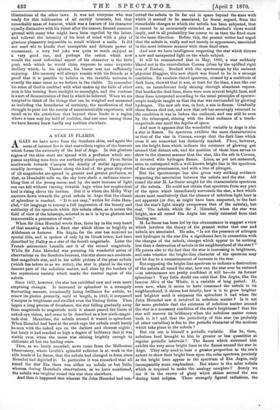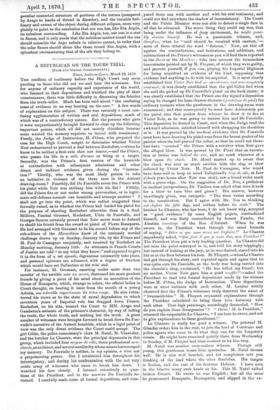A STAR IN FLAMES
AGAIN we have news from the Southern skies, and again the scene of interest lies in that marvellous region of the heavens which forms the extremity of the keel of Argo. In this glorious region of the skies stars are spread with a profusion which sur- passes anything seen from our northerly stand-point. From Sirius southwards towards Canopus the density of stellar aggregation steadily increases. Thence along the keel of the great ship stars of all magnitudes are spread in greater and greater profusion, so that, as Humboldt tells us, the sky here sheds a radiance resem- bling that of the young moon, and by the mere increase of light one can tell without turning towards Argo when her resplendent keel is rising above the horizon. But it is where the Milky Way narrows down towards the great nebula in Argo that the climax of splendour is reached. " It is not easy," writes Sir John Hers- chel, "for language to convey a full impression of the beauty and sublimity of the spectacle which this nebula offers, as it enters the field of view of the telescope, ushered in as it is by so glorious and innumerable a procession of stars."
When Sir John Herschel wrote thus, there lay in the very heart of that amazing nebula a fixed star which shone as brightly as Aldebaran or Antares. Eta Argils, for the star has received no special title, and is spoken of only by its Greek letter, had been described by Halley as a star of the fourth magnitude. Later the French astronomer Lacaille saw it of the second magnitude. While Sir John Herschel was pursuing his wonderful series of observations on the Southern heavens, this star shone as a moderate first-magnitude star, and in his noble picture of the great nebula (which lies before us as we write), the star is placed in the very densest part of the nebulous matter, and close by the borders of the mysterious vacuity which marks the central region of the nebula.
Since 1837, however, the star has exhibited new and even more surprising changes. It increased in splendour in a strangely fluctuating manner, occasionally losing brilliance for awhile, to renew its glories presently, until at length, in 1843, it surpassed Canopus in brightness and rivalled even the blazing Sirius. Then began a long process of decadence, the star falling gradually away from magnitude to magnitude until it almost passed the limits of naked-eye vision, and came to be described as a low sixth-magni- tude star. Meantime, the nebula around it waxed in splendour. When Herschel had been at the south cape the nebula could barely be seen with the naked eye on the darkest and clearest nights ; but lately it had reached so high a degree of brilliancy that it was visible even when the moon was shining brightly enough to obliterate all but the leading stars.
Then, as we lately recorded, news came from the Melbourne Observatory, where Grubb's splendid reflector is at work in the able hands of Le Sueur, that the nebula had changed in form since Herschel had depicted it. In particular it was remarked that all round the star Eta there was either no nebula or but little, whereas during Herschel's observations, as we have mentioned, the nebula was brighter round this star than elsewhere.
And thus it happened that whereas Sir John Herschel had con-
ceived the nebula to lie far out in space beyond the stars with which it seemed to be associated, Le Sueur argued, from the remarkable changes to which the nebula has been subjected, that it cannot be so enormously extended as Herschel's views would imply, and in all probability lies nearer to us than the fixed stars in the same direction. Before this, the present writer had urged that the nebula is, really and not merely in appearance, associated in the most intimate manner with those fixed stars.
And now we have intelligence respecting the star which throws a new and unexpected light on the whole subject.
It will be remembered that in May, 1866, a star suddenly blazed out in the constellation Corona (close by the upliftectright arm of Bootee). Studied with the spectroscope by the eminent physicist Huggins, this new object was found to be in a strange condition. Its rainbow-tinted spectrum, crossed by a multitude of dark lines, showed that it was, at least for the time, a sun like our own, an incandescent body shining through absorbent vapour. But besides the dark lines, there were seen several bright lines, and these lines interpreted according to the usual principles of spectro- scopic analysis taught us that the star was surrounded by glowing hydrogen. The new orb was, in fact, a sun in flames. Gradually those flames died out, and now that orb has seemingly returned to the condition it was in before the outburst, and can still be seen by the telescopist, shining with the faint radiance of a tenth- magnitude star amid the depths of space.
And now it appears that the wonderful variable in Argo is also a star in flames. Its spectrum exhibits the same characteristics as that of the star in Corona, except that the dark lines which cross it are somewhat less distinctly marked. There, however, are the bright lines which indicate the existence of glowing gas around that distant orb, and the position of those lines serves to show in the clearest manner that the star, like the orb in Corona, is covered with hydrogen flames. Lines, as yet not measured, seem to correspond with a well-known bright line in the spectrum of the solar prominences, and with a line of nitrogen.
But the spectroscope has also given very striking evidence respecting the association between the nebula and the star. All round the star M. Le Sueur sought for the characteristic spectrum of the nebula. He could not obtain that spectrum from any part of the space which immediately surrounds the star, a fact which shows most conclusively that the absence of nebulous light here is• not apparent (or due, as might have been suspected, to the fast that the star's light simply overpowers that of the nebula), but real. The nebula which Sir J. Herschel, when the star was bright, saw all round Eta Argils has really retreated from that blazing sun.
M. Le Sueur has been led by this circumstance to suggest a view which involves the theory of the present writer that star and nebula are associated. He asks, " Is not the presence of nitrogen and hydrogen in the star Eta a significant fact in connection with the changes of the nebula, changes which appear to be nothing less than a destruction of nebula in the neighbourhood of theater?' He points also to the fact that the star is increasing in brightness, and asks whether the bright-line character of the spectrum may not be due to a commencement of increase in the star.
But supposing the bright-line spectrum to indicate a destruction of the nebula all round the star, how can the star ever be restored —as astronomers are pretty confident it will be—to its former splendour ? Very little doubt can exist that Eta Argils, like the famous Mira of the Whale, is a variable of long period. If, even now, when it seems to have consumed the nebula in its neighbourhood, it shines but faintly, how is it to grow brighter and brighter until it surpasses the splendour it had when Sir John Herschel saw it involved in nebulous matter ? Is it not far more probable that the existence of nebulous matter around the star is a necessary condition of the star's brightness ? that the star will recover its brilliancy when the nebulous matter comes back to it ? and that the periodicity of this star (as probably of other variables) is due to the periodic character of the motions which take place in the nebula ? But our sun is himself a periodic variable. Has he, then, nebulous food brought to him in greater or less quantities at regular periodic intervals ? The flames which surround him exhibit the very same bright lines as the flames around the star in Argo. They only need to bear a greater proportion to the sun's extent to show their bright lines upon the solar spectrum precisely
as the bright lines appear in the spectrum of Eta Argils, only incomparably more resplendent. But where is the solar nebula
which is required to make the analogy complete ? Surely we see it in the crown of glory which shines around the sun during total eclipses. Those strangely figured radiations, the
peculiar contorted structure of portions of the corona (compared by Arago to hanks of thread in disorder), and the variable bril- liancy and extent of the object during different eclipses, seem very plainly to point to the conclusion that our sun has, like Eta Argils, its nebulous surrounding. Like Eta Argils, too, our sun is a star in flames, and it only needs that the nebulous matter round the sun should resemble the Argo nebula in relative extent, in order that the solar flames should shine like those round Eta Argils, with a splendour overmastering that of the orb they belong to.



































 Previous page
Previous page